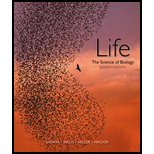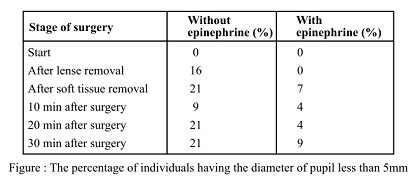
To review:
The part of the iris that is affected by the epinephrine injection, on the basis of experimental results obtained from the surgeries performed with or without epinephrine.
Given:
A cataract refers to the clouding of lens that can occur either due to exposure to ultraviolet light or due to aging. The eye lens in this condition becomes cloudy and nontransparent. For the proper sight, the cataract that is the cloudy lens needs to be removed by the surgeon. In doing so, the surgeon has to make sure that pupil is dilated properly and for a longer time. The dilation of the pupil is controlled by adrenal medulla that releases epinephrine and norepinephrine.
Researchers conducted an experiment to deduce if epinephrine can help in keeping the pupil dilated for a longer time during cataract surgeries. They injected epinephrine into the eye of 27 patients for cataract surgery and did not inject in the eyes of 43 other patients that were also taken into consideration.
The table data shows the patients percentage whose eyes had the pupil diameter size less than 5 mm during the different stages of cataract surgery:

Introduction:
The eye is an important vision organ and its improper functioning causes loss of sight. To cure cataract, which is a disease where the lens of the turns a bit cloudy and nontransparent, people go to surgeons for different surgeries. For the surgery to take place properly, the pupil which is a opening in iris of eye should be properly dilated. The pupil dilation is controlled by various hormones.
Explanation of Solution
Iris forms the major part of the eye, is a thin and circular aperture and is responsible for the contraction and dilation of the pupil of eye. Along with the two types of muscles that constitute the iris, pupil is present. The pupil is responsible for the amount of light that reaches the retina of eye. The size of the pupil is variable and can increase or decrease according to the amount of light to be perceived. It is controlled by the hormone epinephrine that helps in its dilation, which in turn, helps in the better perception of light.
During the experiment, epinephrine (which was injected into the patient’s eye for cataract surgery) dilated pupil and helped in the surgery. Thus, the injected epinephrine affects the pupil of the eye causing it to dilate and increasing in size. The increase in size makes it easier for the surgeons to carry out the surgery. It is clearly evident by the results of the two cases that epinephrine injected patients have less percentage of those having pupil diameter <5 mm while the patients that were not injected by epinephrine have a larger percentage at all the stages of surgery. Epinephrine controlled the diameter of pupil and injected patients pupil remain dilated during the surgery.
Hence, it can be concluded that pupil is the smallest opening in the iris of the eye, which is affected when epinephrine is injected into the patients. The presence of epinephrine in the eye causes the pupil to dilate and increase in size while the absence of epinephrine keeps the size of the pupil small as interpreted from the experiment’s data.
Want to see more full solutions like this?
Chapter 40 Solutions
Life: The Science of Biology
- Describe and give a specific example of how successionary stage is related to species diversity?arrow_forwardExplain down bellow what happens to the cell in pictures not in words: Decreased pH in mitochondria Increased ATP Decreased pH in cytosol Increased hydrolysis Decreasing glycogen and triglycerides Increased MAP kinase activity Poor ion transport → For each one:→ What normally happens?→ What is wrong now?→ How does it mess up the cell?arrow_forward1.) Community Diversity: The brown and orange line represent two different plant communities. a. Which color represents the community with a higher species richness? b. Which color represents the community with a higher species evenness? Relative abundance 0.1 0.04 0.001 2 4 6 8 10 12 14 16 18 20 22 24 Rank abundance c. What is the maximum value of the Simpson's diversity index (remember, Simpson's index is D = p², Simpson's diversity index is 1-D)? d. If the Simpson's diversity index equals 1, what does that mean about the number of species and their relative abundance within community being assessed?arrow_forward
- 1.) Community Diversity: The brown and orange line represent two different plant communities. a. Which color represents the community with a higher species richness? b. Which color represents the community with a higher species evenness? Relative abundance 0.1 0.04 0.001 2 4 6 8 10 12 14 16 18 20 22 24 Rank abundance c. What is the maximum value of the Simpson's diversity index (remember, Simpson's index is D = p², Simpson's diversity index is 1-D)? d. If the Simpson's diversity index equals 1, what does that mean about the number of species and their relative abundance within community being assessed?arrow_forwardwhat measures can a mother to take to improve the produce of her to milk to her newborn baby ?arrow_forward1. Color the line that represents all ancestors of the Eastern white pine tree green (but only the ancestral line NOT shared with other organisms) 2. Oncle the last common ancestor of the Colorado blue spruce tree and Eastern white pine tree. 3. Put a box around the last common ancestor of the sugar maple tree and the dogwood tree. 4. Put a triangle around the last common ancestor of the red pine tree and the american holly bush. 5. Color the line that represents all ancestors of the Ponderosa pine tree red (including all shared ancestors). 6. Color the line that represents all ancestors of the American elm tree blue (including all shared ancestors). 7 Color the line that represents all ancestors of the Sabal palm tree purple (including all shared ancestors) 8. Using a yellow highlighter or colored pencil, circle the clade that includes all pine trees. 9. Using a orange highlighter or colored pencil, circle the clade that includes all gymnosperms 10. Can you tell…arrow_forward
- You have been hired as a public relations specialist to give invertebrates a good name. After all, they are much more than just creepy crawly bugs! Your first task though is to convince yourself that is true. The best way to do that is to start close to home. Find something in your house that is a product obtained directly from an invertebrate or only due to an invertebrate’s actions. Describe the product, its function and utility, as well as any human manufactured alternatives. Be sure to highlight the advantages of obtaining this directly from nature. Keep in mind, a product can be something you use, wear, eat, or enjoy for its visual appeal.arrow_forwardUse the following tree diagram to answer Questions #8-10. 8) Which of the following two animals are the most closely related based on the tree to the left? a) Pig and camel b) Hippo and pig c) Deer and cow 9) CIRCLE on the tree diagram where the common ancestor between a hippo and a cow is. 10) Put a SQUARE on the tree diagram where the common ancestor between a pig and a peccary is.arrow_forwardExplain: Healthy Cell Function Overview→ Briefly describe how a healthy cell usually works: metabolism (ATP production), pH balance, glycogen storage, ion transport, enzymes, etc. Gene Mutation and Genetics Part→ Focus on the autosomal recessive mutation and explain: How gene mutation affects the cell. How autosomal inheritance works. Compare the normal and mutated gene sequences simply. → Talk about possible consequences of a faulty hydrolytic enzyme.arrow_forward
- Can you fill out those termsarrow_forwardExplain down bellow what happens to the cell: Decreased pH in mitochondria Increased ATP Decreased pH in cytosol Increased hydrolysis Decreasing glycogen and triglycerides Increased MAP kinase activity Poor ion transport → For each one:→ What normally happens?→ What is wrong now?→ How does it mess up the cell?arrow_forwardAn 1100 pound equine patient was given 20 mg/kg sucralfate 3 times a day, 2.8 mg/kg famotidine twice a day, and 10mg/kg doxycycline twice a day. Sucralfate comes as a 1 gm tablet, famotidine as 20 mg tablets, and doxycycline as 100mg tablets. All are in bottles of 100 tablets.How many total mg are needed for the patient and how many tablets of each would be needed to provide each dose?How many bottles of each would be needed to have available if this patient were to be on this drug regimen for 5 days?arrow_forward
 Principles Of Radiographic Imaging: An Art And A ...Health & NutritionISBN:9781337711067Author:Richard R. Carlton, Arlene M. Adler, Vesna BalacPublisher:Cengage Learning
Principles Of Radiographic Imaging: An Art And A ...Health & NutritionISBN:9781337711067Author:Richard R. Carlton, Arlene M. Adler, Vesna BalacPublisher:Cengage Learning Human Physiology: From Cells to Systems (MindTap ...BiologyISBN:9781285866932Author:Lauralee SherwoodPublisher:Cengage Learning
Human Physiology: From Cells to Systems (MindTap ...BiologyISBN:9781285866932Author:Lauralee SherwoodPublisher:Cengage Learning Biology: The Dynamic Science (MindTap Course List)BiologyISBN:9781305389892Author:Peter J. Russell, Paul E. Hertz, Beverly McMillanPublisher:Cengage Learning
Biology: The Dynamic Science (MindTap Course List)BiologyISBN:9781305389892Author:Peter J. Russell, Paul E. Hertz, Beverly McMillanPublisher:Cengage Learning





